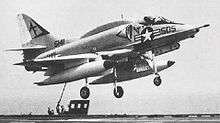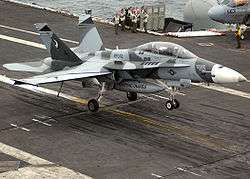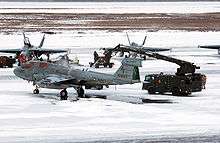Tactical Support Wing
The Tactical Support Wing (TSW) is a United States Navy reserve air wing whose primary mission is operational and training support for active forces. Based at Naval Air Station Joint Reserve Base Fort Worth, the wing is composed of five squadrons and five Squadron Augment Units (SAU) in seven states.
| Tactical Support Wing | |
|---|---|
| Active | CVWR-20: 1 April 1970 – 31 March 2007; TSW since 1 April 2007 |
| Country | |
| Branch | |
| Type | Carrier Air Wing |
| Garrison/HQ | Naval Air Station Joint Reserve Base Fort Worth |
| Engagements | Operation Deny Flight |
| Commanders | |
| Current commander | CAPT Mark Brazelton |
It is the Navy Reserve's only tactical wing, and has been since the 1994 disestablishment of the Navy's West Coast reserve air wing (CVWR-30).
In 2007, the wing was renamed from Reserve Carrier Air Wing 20 (CVWR-20) under the Navy's Active-Reserve Integration (ARI) plan.
Mission
To support active forces and assist in training services, exercise support, counter narcotic operations, fleet contributory support, and preparation to deploy to any protracted conflict and operate as an integrated air wing. The wing would also respond during a national crisis.[1]
Subordinate units

The Tactical Support Wing consists of five squadrons:[1]
- VFA-204 River Rattlers – based at NAS JRB New Orleans, Louisiana
- VAQ-209 Star Warriors – based at NAS Whidbey Island, Washington State
- VFC-12 Fighting Omars – based at NAS Oceana, Virginia
- VFC-13 Saints – based at NAS Fallon, Nevada
- VFC-111 Sundowners – based at NAS Key West, Florida
History

TSW/CVWR-20 squadrons have operated from virtually every carrier in the Navy, including cyclic operations aboard USS John F. Kennedy (CV-67) in 1971, 1996; USS Independence (CV-62) in 1978;USS Lexington (AVT-16) in 1981; USS Carl Vinson (CVN-70) in 1982; USS Dwight D. Eisenhower (CVN-69) in 1984, 1985, 1989; and USS Forrestal (CV-59) in 1987. The air wing embarked aboard the USS John C. Stennis (CVN-74) in June 1996 to conduct cyclic operations on the Navy's then-newest aircraft carrier. Regular operational deployments have been conducted at the Naval Strike and Air Warfare Center (NSAWC) at NAS Fallon, Nevada, as well as numerous detachments to other Navy and Air Force installations. Overseas operations have been conducted in Bosnia and Herzegovina, Bermuda, Brazil, Denmark, France, Hawaii, Iceland, Italy, Norway, Panama, Turkey, the United Kingdom, and Venezuela to advance air wing tactics, readiness and fleet support.[1]
In February 1996, the Naval Reserve reestablished Squadron Augment Units (SAUs) to help ensure an adequate supply of Fleet Reserve Squadron (FRS) pilots. This action improved fleet mobilization readiness and increased pilot training throughput with minimal cost growth. The SAUs established to support VFA-106 and VFA-125 consisted of 10 SELRES pilots, two TAR pilots, 25 TAR enlisted members, and 35 SELRES enlisted members per squadron. A SAU for VAQ-129 was also established at NAS Whidbey Island, with similar staffing.[1]
The two Reserve Carrier Air Wings, CVWR-20 and CVWR-30, were established on 1 April 1970 followed by two carrier ASW group [CVSGR-70 and CVSGR-80] on 1 May 1968. This was a continuation of a program initiated in July 1968 to give Naval Air Reserve squadrons an improved combat readiness and mirror active duty squadrons and carrier air wings.[1]
In 1996, CVWR-20 and its squadrons, VF-201, VFA-203, VFA-204, VAQ-209, VAW-78 and HC-85, completed their much-needed two-week annual training aboard Stennis — "much needed" because CVWR-20 had not operated together as a carrier air wing aboard and around an aircraft carrier since 1989.[1]
In the following two years, Naval Reservists of Carrier Air Wing Reserve 20 (CVWR-20) worked on the flight decks of multiple carriers. Some CVWR-20 aviators landed on the deck of every aircraft carrier on active duty today. But even this seasoned Wing and its Sailors broke new ground in April 1998 when they embarked on USS KITTY HAWK (CV-63) for the ship's flight deck certification. Approximately 240 pilots, air crew and maintenance people from CVWR-20 embarked KITTY HAWK off the coast of Southern California for a busy 10-day underway period that included flight deck certification, Command Assessment for Readiness and Training II, Precision Aircraft Landing certification and an Afloat Training Group visit. The wing and its detachment of seven F-14 Tomcats, two EA-6B Prowlers and one E-2 Hawkeye completed over 150 traps. This was the first flight deck certification Air Wing 20 has been involved in. In addition to a busy schedule, a large part of Kitty Hawk's Air Department had never conducted flight operations at sea. But the mission was accomplished in a very short time frame.[1]
In the summer of 1998 CVWR-20 completed a one-month deployment to Incirlik, Turkey in support of Operation Deny Flight.[1]
In May 2000 sailors of Carrier Air Wing Reserve TWENTY (CVWR-20) operated aboard USS John F. Kennedy (CV-67) for two weeks, supporting a series of tests evaluating the Cooperative Engagement Capability (CEC) system. CVWR-20 launched sorties in support of the evaluation and took advantage of the underway period to sharpen war fighting skills and achieve important qualifications as well. This detachment was especially important to VFA-201 because it was their first at-sea period since they transitioned to the F/A-18 Hornet. Several pilots qualified in carrier operations for the first time in the Hornet, making arrested landings with an impressive boarding rate. VFA-201 also fired their first air-to-air missiles from the Hornet, launching three AIM-9 Sidewinder heat-seeking missiles and two AIM-7 Sparrow radar-guided missiles in a variety of profiles at a number of different targets. In another first for CVWR-20, five Marine Corps Reserve Hornets from VMFA-142 joined them for CQ, qualifying all five pilots. Three of the Hornets then flew to NAVSTA Roosevelt Roads where they flew Orange Air missions in support of CEC.[1]
Current operations

Commander, Tactical Support Wing, located at Naval Air Station Joint Reserve Base Fort Worth, TX, has operational and administrative control of the Air Wing. The wing consists of more than 1,900 active duty and Selected Reservists (SELRES).
The SELRES represent a unique personnel asset as a civilian/sailor who performs one drill weekend each month and up to twelve days of active duty each year. The squadron's active duty FTS (Full Time Support) cadre is jointly responsible for SELRES training and the maintenance of unit readiness required for crisis response. In today's smaller Navy, Reservists are performing more duties once filled by active duty units. While Reservists are obligated to drill a minimum of two days per month and incur a two-week Annual Training session, Sailors in TSW far exceed that, averaging seven to 10 days a month, or about 100 days a year.[1]
The organization structure of TSW mirrors that of active fleet carrier air wings, with the exception of a F/A-18E Super Hornet squadron, a F/A-18F Super Hornet squadron, an E-2C Hawkeye squadron and MH-60S Seahawk and MH-60R Seahawk squadrons. Two TSW squadrons are also equipped with land-based, non-carrier capable, F-5F/N aircraft.
The air wing is capable of immediate mobilization when directed to meet commitments required by higher authority. VMFA-142 (Marine Fighter Attack Squadron 142) was previously designated as the U.S. Marine Corps Reserve component of this reserve carrier air wing, supplementing the three existing VFA squadrons. The wing conducted USMC Integration with the VMFA-142 "Flying Gators" every other year until July 2008, when the squadron was placed in "cadre" status pursuant to BRAC action which closed its home station of NAS Atlanta at Dobbins ARB, Georgia and pending VMFA-142's transition to the F-35B Lightning II. It has yet to be determined if the Marine Corps' sole remaining Reserve F/A-18 squadron, VMFA-112, will assume VMFA-142's previous role with respect to TSW.
Following the inactivation of Helicopter Wing Reserve (HELWINGRES) at NAS North Island, California, HS-75 at NAS Jacksonville, Florida also previously chopped to TSW in a Mobilization status, as it also had done with CVWR-20, and provided the flexibility to immediately integrate and operate with Regular Navy counterparts with its SH-60F and HH-60 Seahawk aircraft. HS-75 was deactivated March 2007 and its assets redistributed to Regular Navy HS squadrons.[1]
Fixed-wing aircraft
- F/A-18A+/C Hornet
- EA-18G Growler
- F-5F/N Tiger
See also
References
- "Carrier Air Wing Reserve Twenty". US Navy. Global Security.org. Retrieved 29 December 2006.
- RDML Jeffrey A. Lemmons, USN, Carrier Air Wing Reserve 20, The Hook Magazine Winter 06, Tailhook Association
External links
- CVWR-20: Firepower in Reserve – Naval Aviation News (January–February 2003)
